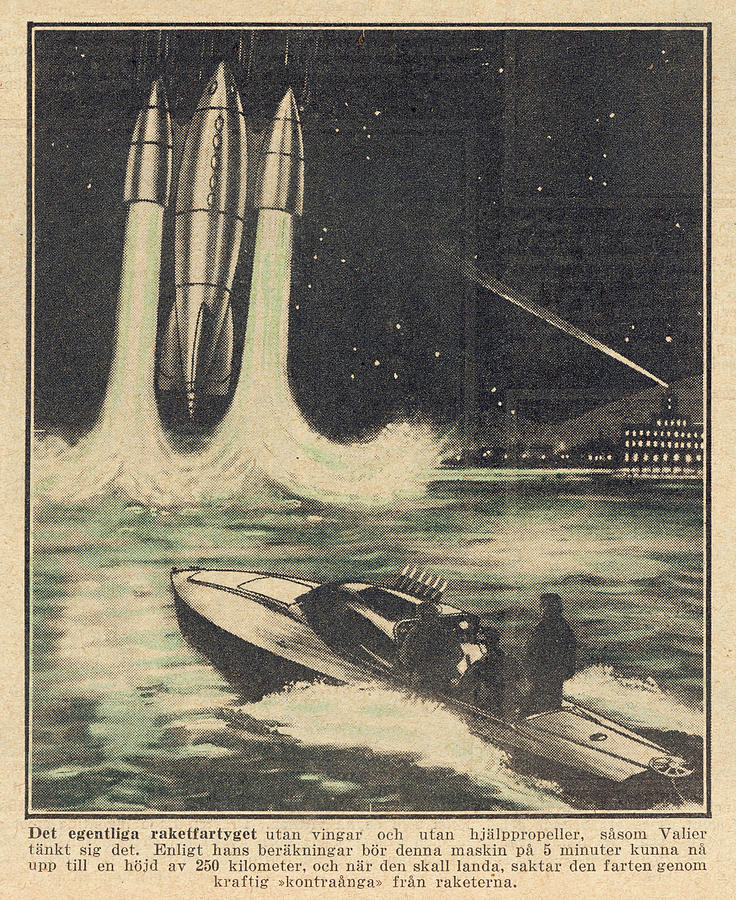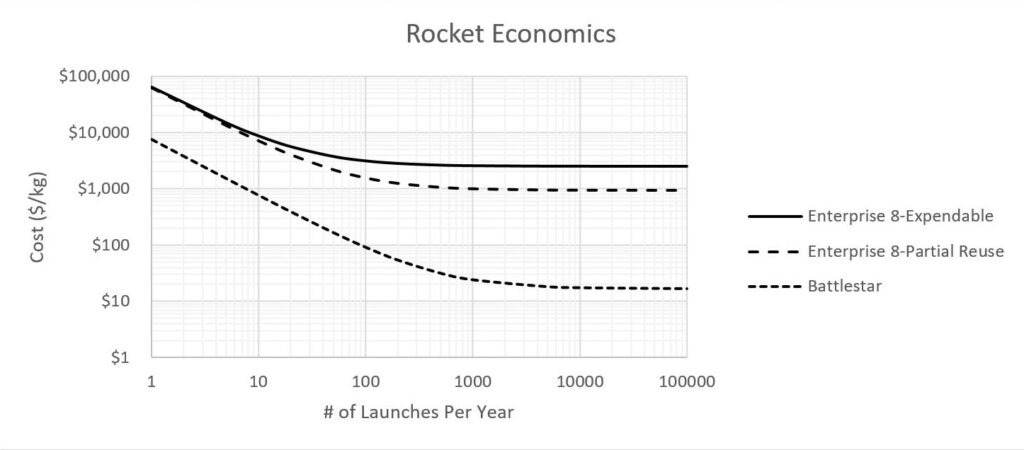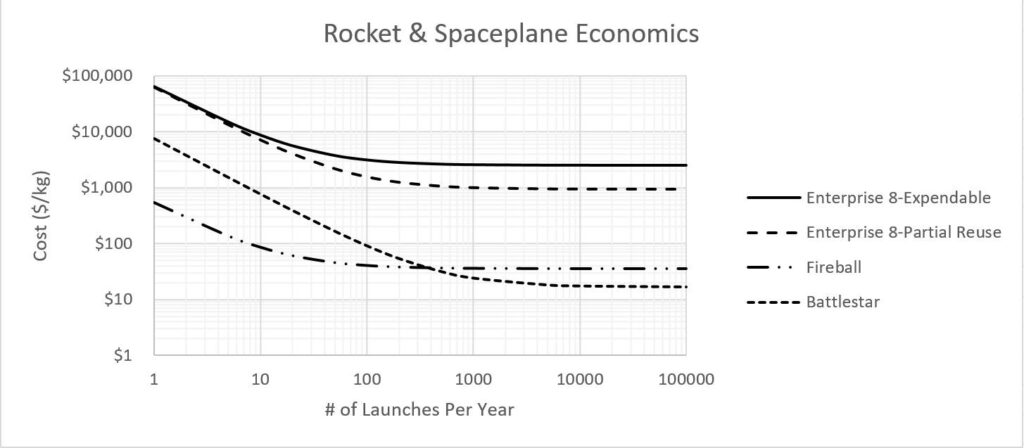I’ve been doing some thinking after writing How Cheap Can Rockets Get a lot of thinking. If you recall, my big conclusion was that although there is the potential for rockets to get orders of magnitude cheaper, they would still be an expensive means of transportation by terrestrial standards. Likely too expensive to do any of the interesting use cases we have in mind. There had to be a better way.
This led me down the fascinating rabbit hole of non-rocket space launch. Many of these ideas like space elevators and launch loops are really just napkin sketches. We don’t even know if some of them are possible. A set of concepts that seem quite feasible is to use electricity to launch things into space. People have proposed things like electromagnetic catapults, lasers, or even spinning rotors. All extrapolations of tech we have today but it turns out that they don’t really scale that well. It turns out that rockets are incredibly efficient heat engines. You’ve probably heard the statistic that a single Space Shuttle main engine produces the power output of 7 Hoover damns! That means it would probably require building the U.S. electrical generation infrastructure several times over to support the kind of launch cadence and tonnage we have today!
There is one idea for non-rocket space launch that feels just about ready for prime time – space planes. Space planes are an old dream. German rocket pioneer Max Valier was vociferously advocating for them back when Werner von Braun was still an undergrad. To Valier, space travel should be a natural evolution of high speed air travel, a philosophy espoused by many a space plane proponent. He imagined a vehicle that could operate out of any airport, fly to space under its own power, and return to a runway like any other aircraft.


Rockets became the dominant form of space launch, but work on space planes never stopped! I could go on and on about Eugen Sanger, BOMARC, HOTOL, & the X-30. Heck a we technically did fly the Shuttle, more of a rocket boosted glider, but at least got the runway landing part down!
The hard part about spaceplanes has always been the propulsion. Most concepts utilize a combined cycle engine. Such an engine would start in an airbreathing mode, using Earth’s atmosphere as a source of propellant, just like a jet. It would then switch to a pure rocket engine at the edge of the space and continue to orbit like any other launch vehicle. By using the atmosphere as propellant, a combined cycle engine would be orders of magnitude more efficient than a conventional rocket. So efficient that the spaceplane could reach orbit on a single stage, a true airplane to space.
Combined cycle engine technology is really hard to do, with engineers comparing to the challenge of keeping a match lit in a hurricane. However there has been explosive progress in hypersonic vehicles over the past 10-15 years, most of it funded by the military. Many of the underlying challenges are being addressed and it has even been rumored that such a combined cycle engine is already flying. I feel somewhat comfortable saying that spaceplanes are no longer an if but a when.
If you remember from our previous chat on rockets, we looked at two types of launch vehicles. An expendable/partially reusable medium lift rocket called Enterprise 8 and a fully reusable heavy lift rocket called Battlestar. Remember how the cost of launching these vehicles is dependent on three things: the infrastructure cost of running your space company, the production cost of building new vehicles and stages, and the propellant cost of fueling up your vehicle. Further recall how as the number of launches increases the cost per launch tends to be dominated by the cost of propellant and the cost of building expendable hardware. Eventually the economics are mostly driven by the cost of fuel. The rocket can only get so cheap.

Let’s add a spaceplane to this, we’ll call it Fireball. Fireball like other proposed spaceplane concepts would be a single stage to orbit vehicle, probably powered by hydrogen and oxygen. Fireball can deliver about 15,000 kg to orbit then return to a runway to be used over and over again. Fireball’s greatest advantage is that it can fly out of any commercial airport. Not needing to support launch pads or integration facilities results in orders of magnitude lower infrastructure cost than a rocket. For this analysis let’s say it’s about a 100x reduction.
The results are below and to be honest I was a bit surprised. Fireball, a flappin SSTO spaceplane actually ends up being a slightly more expensive way of putting mass into orbit than Battlestar! Why is this?

Having lower infrastructure cost up front really helps Fireball initially compete with Battlestar. However as flight rate increases both system’s amortize their fixed infrastructure costs to functionally be zero and Battlestar’s large payload size quickly trumps Fireball’s initial advantage.
That said, given where the launch industry is today a vehicle like Fireball would be the lowest cost means to access space by far. There may be an age of spaceplanes yet but the window is closing. The U.S. alone is already launching over 100x rockets a year out of the existing pads. Enough new pads are being built to easily double or quadruple that number.
I am particularly nostalgic for flying boats. They represent a lost golden era where air travel was a glamorous adventure. I think we may one day look back on spaceplane concepts in a similar way. Like flying boats were to the dawn of aviation, space planes were to the dawn of space travel. The obvious choice when the technology and infrastructure were immature. But as with flying boats technology and the world at large has surpassed the original vision. We may gain a future of mass space travel on giant rockets, but we may lose the dream of a spaceplane in every airport.
Seaplanes and flying boats are still around though. The arrival of the jet airliner did not fully end them. They have their niche and I think spaceplanes will too. There are all kinds of missions an SSTO spaceplane may be great at and they will absolutely have a role to play in our space future! Just not for the reasons you think.
